|
Chi Kung is one of China's greatest achievements

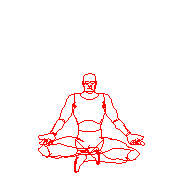 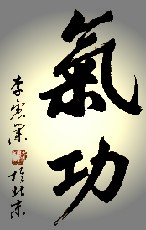

Originally, Qi-Gong was developed for general exercise, and to keep the body free from illness and disease.
Qi gong was created from the accumulated experiences of countless generations by thousands of wise men and sages. Many of the theories and training methods have been kept secret, and only recently made available to the general public.
Practicing Qi-gong aids and assists in the healing process of the body. Qi-gong is concerned with the flow of energy in the body. The energy or chi flows along what the Chinese call meridians.
The philosophy of Taoism employs Qi-gong practise and cultivation to maintain harmony with nature and the universe.
Qi gong practise and training is based on adopting Chi or energy from nature and the universe to strengthen and balance the mind, body and spirit, through breathing and vocal exercises, movement and meditation. At a later stage other methods of development were introduced, which involved strengthening the muscles, tendons and bones, washing the bone marrow and nourishing the brain. (iron shirt qi gong training).
These later methods were required to reverse the degeneration of the organs and the body, which was necessary for old age and good health.
Fundamentally, Qi gong is divided into 2 sections: internal and external. When starting Qi gong practise, initially, we learn how to relax the mind, relax the body, exercise the lungs and regulate the breathing by practising moving Qi gong and clean body Qi gong.
Practicing moving, clean body Qi gong will clean the rubbish and toxins out of the body, clear blockages from our body and relax our muscles, tendons and nerves. This in turn will keep our psychology happy and strong, exercise our lungs, which then will relax and calm our entire body and organs, especially the heart.
When we have learned to dispel the rubbish and tension from our bodies and relax our minds and regulate the breathing, we can now start to incorporate some still meditation. This will help to control the Kan and Li (water and fire) aspects of our bodies.
As our body becomes more relaxed, calm, happy and free from tension and stress our blood circulation, nervous system, endocrine glands, and the function of the body and organs will then be strengthened, regulated and balanced.
When we have dispelled all the rubbish from our bodies and accumulated sufficient Qi or energy through practise, then we are ready to incorporate Iron Shirt Qi gong training.
Qi-Gong restores the vital energy expended through life, and as we get older, practising qi-gong will keep our bodies strong, flexible, supple, young and happy. Qi-Gong stimulates change and enriches our life through attaining physical and emotional balance; placing us in touch with our own physic force. As we become more advanced in our practice, we slowly develop a psychic and spiritual awareness, unique and relative only to ourselves.
History :
Qigong is an ancient Chinese art used for healing and strengthening body, mind, and spirit. Qigong combines movement, mediation, and breathing as a means of cultivating and enhancing the bodyís natural internal energy (qi) while increasing awareness of its flow throughout the body.
Qi is ďIifeforceĒ or ďvital energy.Ē Itís the fuel that powers the universe, the energy in us and all around us. Gong means ďwork.Ē Qigong then is ďenergy work.Ē Qigong patterns (and there are literally thousands) are typically stationary, legs staying in place. Tai Chi Chuan is actually a form of Qigong, a type of moving energy work.
Qigong is a 5,000 year old Chinese health care modality, a powerful healing system. Millions of people practice Qigong in China and around the world each day to successfully treat diseases ranging from hypertension to cancer.
In Chinese the word "Qigong" has two characters, Qi (Chi) and Gong. "Qi or chi" means life energy and "Gong" means daily effort. In short, Qigong is a practice to use chi for different purposes including self-healing. Everyone is born with chi and everyone has the potential to use chi for many purposes. It is the same way as swimming, we are born with the potential to swim but only when we acquire the skill to swim then we can enjoy different water activities such as scuba diving, water polo, free style, butterfly swimming, etc. In the same manner, the skill to use chi is trained not born. Once a person is trained how to use chi, he or she then can use chi for martial arts, dancing, weight lifting (yes, weight lifting as the Chinese trained weight lifters using qigong!) and of course, medical, self-healing.
Is Qi "Real?"
Qi (chi) is usually defined as "vital energy", in other words, the energy of life. The word qi in Chinese combines metaphorically with many other words to give a dynamic, living quality. For example, sky qi means "weather." In the literal sense, dead things have no qi, but all living things do have some qi, no matter how weak or how little. A finite amount of qi is inherited at birth from one's parents, and Qi is supplemented throughout life through food and breath. Qi nourishes the all the organs of the body, and all the body's living processes develop qi.
Qi is generally invisible, although it may be what's photographed in Kirlian photography. Also halos and the aura may be related to qi. At any rate, thus far qi is definitely unquantifiable, which is why Western medical science has not incorporated it. So, is it real, or is it simply a symbolic way of thinking about energy?
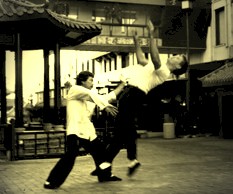
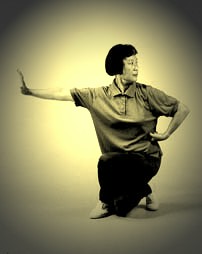
The answer in Chinese thought is a resounding: Yes, qi is real! The evidence of the existence of qi is not that it can be seen (at least, not usually) but that it can be felt. Acupuncturists treat all manner of diseases and ailments by determining blockages and irregularities in the natural flow of qi throughout the body. An acupuncturist requires his patient to be able feel when his qi has been intercepted by the needle as essential feedback in the treatment. Some experts believe qi is electromagnetic in nature, relating to the minute ionic exchanges between cells.
After centuries of elitism where qigong "secrets" were closely guarded and passed down to select few, and brutal suppression of traditional Chinese medicine, taiji and qigong during the Cultural Revolution, qigong is being learned and taught everywhere throughout China today. Extensive scientific research is being conducted, and certain hospitals overflow with reports of cures attributed to qigong. Estimates are that 200 million people practice some form of qigong regularly, making qigong far and away the most popular approach to exercise in the world.
Simple Qi Exercises for the Curious
Here are a few simple exercises which may be able to help you feel your qi.
1. Stand naturally, with your side about a foot from a wall. Raise your arm on that side straight out, until your wrist touches the wall. Press hard with your wrist against the wall for about thirty seconds. Bring your arm down to your side, take a step away from the wall, and relax your arm completely. It will rise, probably higher than it was before. Your qi has been directing your arm to rise outward and upward against resistance, so without the use of voluntary muscles, it will still tend to rise when the resistance is removed.
Do this a few times and remember the sensation of the qi directing your arm to rise. Try standing in a relaxed position, and by remembering the feeling of your qi, make it raise your arm.
2. Hold your arms in front of you, elbows very loosely bent. Your palms should face each other, shoulder width apart. Imagine you are slowly squeezing an accordion as you exhale, ending with your palms just a few inches apart, inhale slowly as you let the accordion fill up and push your palms apart. As you practice, you should be able to feel the qi pushing against your palms.
3. Still standing as before, bring your palms close together, almost, but not quite touching. Move your hands so that the centers of your palms are making ľ-inch circles. A warm, or sometimes "magnetic" sensation should be felt after a few seconds.
4. Walk slowly, and imagine that you're walking through water, instead of air. Feel the qi moving into your hands and feet, as you gently swing them through the "water."
Quote :
True force starts from true softness
True softness starts from your mind
Within stillness there is movement
Within movement there is stillness
Concern yourself with energy not the opponent
Show your enemy nothing
In defense become unknown
Attack with a thousand faces
Dan Tao Qigong: Yi Jing Ching

Sinew Ligament Transformation Work:
According to several oral traditions, the Yi Jing Ching was originally transmitted by the Indian monk, Bodhidharma. Upon his banishment from the Liang empire, he arrived at the Shaolin temple to find that the monks there were weak and could not even sit through the tiring Ch'an meditation sessions. He instituted the practice of Yi Jing Ching--the meaning and content of which is quite similar to that of the Yogic stretches and Asanas.
It is a historical fact that Bodhidharma came to China and brought with him the direct heart to heart transmission of Chan Buddhism. ( Japanese Zen).
The practice of Yi Jing Ching improves the overall strength of body ligaments and connective tissue through vigorous breathing and slapping of the body along the meridian pathways, the energy routes of the body.
The Qigong Stance "Drawing the Bow as if shooting a hawk "
This particular Qigong movement, Drawing the Bow, stimulates the flow of lung Qi/energy.

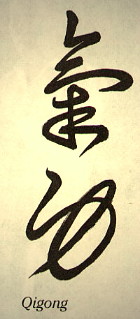
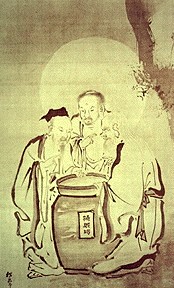
One tunes the lungs by gently stretching open the arms and gazing at the fingertips. This motion creates a gentle lengthening of the spine, thus reducing the pressure on the neck vertebrae.
The Qigong postures assist our flow of Qi by shaping the body and stretching the Qi meridians.
Dan Tao Qigong derives its principles from the meridian system found in Traditional Chinese Medicine combined with the Theory of the Five Elements. By holding the body gently in various positions, one can enhance the flow of Qi and blood to the different areas of the body.
Since the lungs have the protective function in TCM, Traditional Chinese Medicine, the martial-like postures suggest to the brain a fighting spirit of the lungs as a defense against invading infections.
MARROW WASHING QIGONG
:
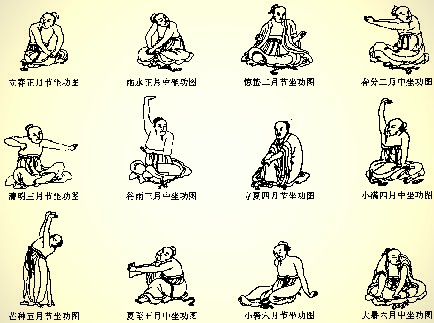
process of aging and extending life. From ancient times, Qigong has been known as a method of eliminating disease and prolonging life.
Wu Dong is the name of the mountain where this Qigong health system was created. In order to define the words "Qigong," it is necessary to understand the concept woven into its two roots, Qi and Gong.
Qi is written with the character that indicates the cooking and steaming of rice, and it is usually used to mean "air," "breath," or even "steam." But, this is only the outer, external breath. The word Qi is used by practitioners of Qigong and the martial arts to mean "internal prana," life force, or biopsychic internal energy. Or in the Latin, " Spiritus", thus inhalation is considered as in-spiritus or inspiration. The flow of breath is the flow of the spirit as well.
The canons of traditional Chinese medicine teach that life and health are a result of the harmonious flow of ample Qi throughout the body. When Qigong movements are said to cultivate Qi, it is this internal Qi that they cultivate. All disease is thought to stem from a disruption in the smooth flow of this internal Qi. Acupuncture is based upon the belief that Qi circulates throughout the body along twelve major meridians, stimulation of which can cure various ailments.
Dr. Joan Barice, a medical doctor with degrees from Stanford and Harvard Universities, points out that Chinese medicine's concept of inseparability of mind and body is compatible with our modern scientific research findings. She explained, "We know, for instance, that movement and acupuncture stimulate the production of endorphins. Endorphins are neurotransmitters with morphine-like activity that give us a feeling of well being and relieve pain. We know that receptor cells are in a constant state of transformation from energy to particle and back again. Western science can identify the receptors and transmitters, but cannot identify or quantify the system interfacing with the one that transforms energy into patterned information. From the Chinese perspective, this interfacing system is simply Qi, the universal intelligence which flows through all living processes and contains the wisdom of healing."
The word gong means "work," and is used in the words Qigong to indicate the diligent practice of movements to help Qi to function properly and efficiently within the body. It is the true meaning of the word gongfu (usually spelled "kung-fu" in English), and refers not only to the duration and quality of one's Qigong practice, but also to the student's determination to learn the movements and practice them. Thus, Qigong must be practiced with one's whole heart, sincerely, diligently, and with continuing perseverance.
Qigong movements cultivate the important connection of mind and body with the abundant energy of the environment. Its movements, mental focus, and breath control stimulate this internal qi flow.
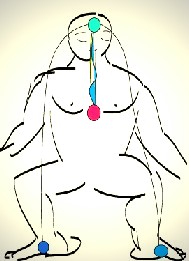
These movements involve three specific modes of action:
To breathe fully, slowly and evenly -- breath is life. We must inhale fully to take in the energy-powered oxygen, and exhale fully to release the toxic carbon dioxide.
To maintain a mental calmness -- focusing leads your thoughts and emotions. The ability to control your focus will lead to a peaceful state.
To move and align the body so your qi and blood flow are enhance and uninhibited. The success in Qigong training is directly related to the correctness of the body's position.
The Marrow Washing Qigong works with the body and separates it into three parts:
The upper portion of our body corresponds to the energy of Yang, or heavenly energy;
The lower portion of our body corresponds to the energy of Yin, or earthly energy; and
The middle portion of our body is the connection of Yin and Yang, or the balance of the body.
The Marrow Washing Qigong movement utilizes the bountiful energy that surrounds us to cultivate, balance and cleanse one's internal Qi. It is common to feel euphoric after doing these movement, as endorphins are stimulated and brain waves turn to an alpha state which represents a relaxed manner.
As well as quickening the healing time of injuries and strengthening the immune system to fight disease, the movement works exceptionally well with the common ailment of stress. The movement will relax the mind and balance the emotions. As the mind calms, a feeling of peace and happiness takes over the senses.
"Qigong movement is the process of generating energy solely to purify the obstructions of the physical body, the emotions and the spirit."
STANDING POST QIGONG
Qigong (or Chi Kung) is a general term that refers to various methods of Chinese exercise. There are literally hundreds, if not thousands, of qigong methods, but each is broadly based on the same philosophical and medical theories. These include the principles of yin and yang, Five Element theory, traditional Chinese medicine, Buddhism, Taoism and so on.
The phrase qigong consists of two Chinese characters: Qi, which can be literally translated as breath, and Gong which is translated as effort or work (as in Gong Fu). So, at one level, qigong means "breathing exercise". At another level Qi also means energy or vitality and, in Chinese medical terms, is often described as a vital force that circulates in the human body (as well as in the world around us). This energy has many components, including the oxygen we breath in, energy from the food we digest and so on. So qigong can also mean exercise to focus and refine the bodyís natural energies.
Broadly speaking there are five different areas of qigong training:
Healing - using qigong for general health
Taoist - to strengthen the body and spiritual development
Buddhist - to develop health and extraordinary potential
Medical - to heal others
Martial - to strengthen the body and increase power
Obviously there is considerable overlap in practice and theory of all these areas, but it is important when beginning qigong to have some idea of what your goals are. For instance, sitting in cross legged contemplation may be an excellent method of spiritual meditation, but it is not designed to improve your ability to take blows. It is also important to start at a basic level if you have not done any qigong training before. At a basic level there is very little or no chance of qigong proving harmful. This is not the case if you go into advanced breathing methods, visualisations or Iron Shirt training. Then there is a real risk of both physical and mental harm. The guidance of a responsible and knowledgeable teacher is important at that stage.
STANDING POST
In Tai Chi Chuan we use an exercise called Standing Post as our base qigong. This is a very simple (but not easy!) method which brings benefits very quickly in a number of areas. For martial artists it is a good qigong to practice because as well as the health benefits, we are also getting some good martial training, both of which Iíll discuss later. In the Yang Family system there are 18 postures in the Standing post set (not just 6 as claimed by some teachers). Students start with the first three basic postures:.
Start in an upright posture (figure 1). Make sure the shoulders and chest are relaxed and the back is straight (but also relaxed - donít "stand to attention"). Spend a minute or so concentrating on your breathing, slowing it down (breath in and out through the nose).
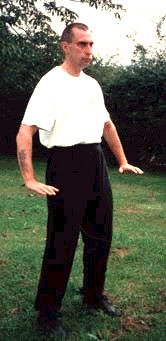 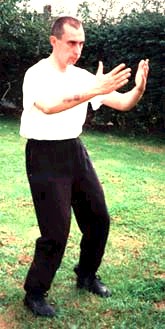
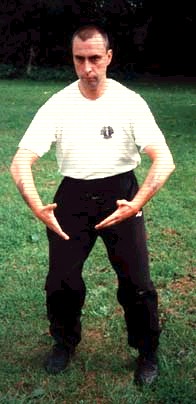
Bend the knees into a "horse stance". Try to get your knees in line with your toes. Make sure the back is still upright - it is very easy to lean forward or back. Get a friend to check, or use a mirror if possible. Slowly raise your hands to shoulder height, with the arms as though you are holding a large ball (fig 2). Keep the elbows a little lower than the wrists in order to help keep the shoulders down. The fingers are opened, but relaxed, there should be no tension in any of the joints. Keep the body weight sinking down into the legs. After a few minutes in this posture, slowly lower the arms to waist height (fig 3). Maintain this position for the same amount of time. To finish, slowly straighten the knees and return to your original posture.
So thatís the exercise. There are three areas we need to look at in order to make the exercise effective:
EXTERNAL PHYSICAL POSTURE
As described above. Take care to ensure an upright back (tucking the pelvis under slightly helps), shoulders and chest relaxed and feet parallel. The feeling is almost like you are about to sit down in a chair.
INTERNAL PHYSICAL POSTURE
This firstly relates to breathing. Breathe in and out through the nose, slowly and gently. Try to breathe from the diaphragm rather than just the chest muscles. At a later stage you can use the reverse breathing method.
The second aspect is what happens to the muscles - they will start to tense, particularly the legs. It is not uncommon for people doing this exercise for the first time to experience shaking legs (even if you think you have strong legs). Try to work through it. To help dissolve the tension try to focus your breath going to that part of your body. Let the tension go rather than fight it.
MENTAL POSTURE
In some ways the most important. I have seen people practice Standing Post for 30 minutes or so, during which time they looked around, spoke to other people and so on. Doing this sort of thing may help your legs a bit, but little else. It is very important that you have a focused and concentrated mind in this sort of training. A common misconception is that we practice qigong and Tai Chi Chuan in a dreamy, trance-like state. This is not the case. Without correct intention (what the Chinese call "yi") the exercise is futile. For a beginner, the focus should first be on the breathing. Feel each breath as it comes in and out. It may help if you count the breathes - work in cycles of 10 - this will certainly aid your concentration. You should also be constantly reviewing your posture and correcting it, trying to relax into any tension and so on. At a later stage, once the above can be achieved without too much conscious thought, the focus can move to other areas.
WHY PRACTICE?
When watching people doing Standing Post most peopleís reaction is that it looks easy - so easy, in fact, that they wonít bother trying it themselves. This is a shame as Standing Post has many benefits.
On a physical level it really does build up the legs. Not only do they become stronger, they also become more relaxed and flexible. Regular practice opens the joints and stretches the thigh muscles. The stance also becomes firmly rooted - by that I mean that you are able to sink all your body weight into the legs. The stronger your stance the more power you can put out or absorb.
Regular practice also helps relax the upper body. Tension in shoulder, neck or arm inhibits the release of power when striking. Likewise tension in the chest inhibits oxygen intake. For those in competition particularly, the ability to move freely and easily while expending less energy is a distinct advantage.
On a mental level, practice develops a quiet concentration and strong focus. Over time you will be able to put this into anything you do. This has profound effects in terms of countering the natural fear and anxiety we all feel when put under pressure. Itís also a good tonic for the mind, the chance to take time out from the rigours of the day. One reason we sleep is to allow the brain to process all the information we take in during the day. Standing Post does the some thing, after practice you should feel more mentally alert and aware.
Standing Post also helps the bodyís natural healing process. By promoting positive relaxation we promote blood flow, oxygen intake and so on. This has a positive effect on recuperating from injury or illness - note however that in case of fever or high temperature it is best not to practice. One other cautionary note - in the early stages of pregnancy it is best to avoid practice (at a later stage it should be OK, but practice only lightly, do not bend the knees too much). Of course, in any such cases you should always follow the advice of your doctor.
At this basic level it is not necessary to have a deep knowledge of the meridian system, or visualise energy travelling from here to there - indeed it would probably be a hindrance. Simply set aside 10 minutes somewhere to stand quietly each day, and within a week you will be feeling benefits.
Wild Goose or Dayan Qigong :
Beginners learn the first set which consists of 64 movements. It usually takes four and a half months to learn the entire set. The second set is reserved for experienced students who have taken the first set at least two times. It also consists of 64 movements. The class is taught by Master Hui Liu.
The Dayan Qigong set is based on the movements of the wild goose. It is structured in a way that enhances the circulation of qi. "Qi" is a Chinese word whose concept is difficult to translate. "Qigong" literally means "qi practice." Like the Sanskrit "Prana", the Japanese "Ki", and the ancient Greek "Pneuma", the word means both the vital life force and its existence.
According to the Chinese theory of medicine, all illness is a result of obstructed qi paths or an imbalance of yin and/or yang. Examples of yin are dark, cold, inner, feminine, and negative force in the universe. Examples of yang are light, hot, outer, masculine, and positive force. Each contains within it the germ of the other. The two are combined in everything and are inseparable from each other. Harmony is disrupted if the yin is too strong or if the yang is too strong.
Both Western physics and Eastern science describe the universe as a vast energy field. Dayan Qigong works to improve the various bodily functions by improving the body's electric and magnetic energy flow and capacity. The movements are organized to follow the flow of the earth's energy and to exchange internal qi (from the body) and external qi (from the earth and the universe), utilizing this energy to stimulate and balance the various functions of the body. Circulation of qi can be governed by the mind. Concentration and relaxation are essential, assuring that qi will flow strongly and without obstruction during practice
conducted in China have found that Dayan Qigong can have a therapeutic effect on hyper- and hypotension, weakness of the heart, insomnia, disturbances of the nervous system, intestinal infections, skin diseases, and mental illnesses. Scientific instruments have detected infra-red and electromagnetic changes in qigong masters and have detected the presence of specific germs and viruses in the air around practitioners after they have expelled the negative chi from their bodies.
The History of Dayan Qigong
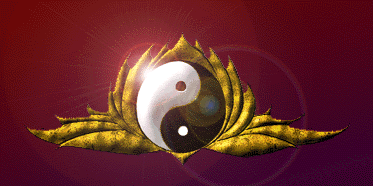
History of Dayan Qigong Four thousand years ago in ancient China, it is said, the legendary Yellow Emperor invented a technique of breathing and movement to vitalize mind and body
Records that describe breathing exercises exist from about 1000 B.C. The Chinese, like the ancient Greeks, believed in a healthy mind in a healthy body, and discovered many techniques that were supposed to enhance health and well-being. It is not known exactly where or when qigong as we now know it began, but there have been many different styles that have evolved through the years.
About 1,800 years ago a venerable Buddhist monk named Dao An developed a form of qigong which he called "Dayan Qigong". Years later another monk named Wan Yi revised and perfected the set. Dayan qigong was handed down from master to student as a secret or esoteric doctrine. It was only in recent years that its potential and benefits have been known to the general public, and today, it is widely taught in China.
In the 19th century, during the Qing Dynasty, Yang Mei Jun's grandfather learned Dayan qigong from a monk. It wasn't until master Yang's grandfather turned 70 that he decided to teach his granddaughter the form. Now Master Hui Liu is teaching the set here in the United States after she had learned the set from Yang Mei Jun. Master Yang herself is a living example of how beneficial Dayan qigong can be. She has been known to cure the terminally ill using only the power of the "qi" from her hands. She can hold a sword in her hands and illuminate the tip with her qi. In the dark it is possible to see two beams of light originating from her eyes. And, just by using her body's qi, she is said to be able to evoke the scents of five different flowers. This last amazing feat was performed recently in China before an audience of over 2,000 people. For over half a century Master Yang practiced in secret, often late at night, so that even her husband knew nothing of what she was doing.
For ten days his life remained in danger until Master Yang applied the power of her qi to heal the man's injuries. The government then declared that Dayan qigong should be available to all who desired to learn it. Recently the form has become widely taught, and Master Yang herself has become a special kind of "national treasure" in China. "Dayan" means "wild goose". In the Zhou Dynasty a wild goose was included in wedding gifts as a symbol of marital fidelity. In later times a wild goose was embroidered on the court robes of officials who had advanced in the civil examination system to the third highest level. The wild goose exemplifies high culture and in ancient China it was not customary to kill them for food or game.
According to traditional Chinese thoughts, the wild goose embodies
the Five Constant Virtues: "Ren"--ethics and perfect virtue free from
selfishness; "Yi"--right conduct, loyalty, and faithfulness;
"Li"--respect, reverence, and good manners; "Zhi"--wisdom, knowledge,
cleverness, and prudence; and "Xin"--truth and sincerity. Wild geese
migrate long distances, flying 1000 miles or more. They fly in a "V"
formation, following naturally in a line. They always migrate on the
same day to the same place. They supposedly mate for life. When a mate
dies the survivor laments and does not seek another mate. When the
flock sleeps, they post sentries to warn of approaching danger.
Though they are water birds, they are generally vegetarian. Thus,
say the ancients, "to be a good person one must be like a wild goose."
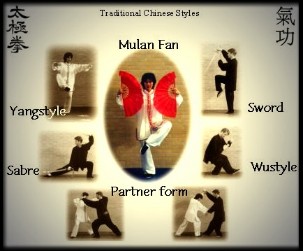
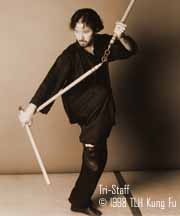
IRON SHIRT QI GONG
What is Iron Shirt Chi Kung ?
Iron Shirt Chi Kung is the martial arts aspect of the Universal Tao System which develops internal power and a well-conditioned body through simple techniques that build and store Chi. The Iron Shirt training first of all develops a body that is relaxed, open, strong and structurally aligned with the forces of the universe and earth. The Iron Shirt techniques help us to become rooted to the earth, thereby keeping the body centered and balanced.
Chi Kung is a form of internal alchemy that involves mind, Chi power and breathing exercises. It teaches how to detoxify the body in order to stimulate the flow of energy and to pack and condense Chi. Thereafter, to circulate it in the body and to use the breath to pack the organs, glands, muscles and bones with Chi so that they will stay healthy and strong.
All the Iron Shirt Chi Kung movements and breathing exercises should be done mindfully in order to reach the deeper emotional layers of your body. The ultimate goal is to prepare the body for the higher spiritual energies.
Iron Shirt Qi gong was introduced to the Shaolin monks by Budhidharma, around 540 AD. These classics were tabulated as “ Bone marrow washing’ and “Muscle and Tendon change classic”. During the mid 17th century, the 5 Elders of the Shoaling Temple were foremost in their development of Iron Shirt training and Iron Palm.
Abbot Jee Shin was an iron head Qi gong Master. Bak Mei was an iron body Qi gong Master. Ng Mui, the Abbess was an iron palm Dim Mak Qi Gong Master. Fong Sai Yuk was an infamous swordsman and Master in emanating Chi. Miu Hin was a Qi gong master in emanating Chi power.
The 5 Elders were also Experts in various styles of Shaolin Kung Fu, being responsible for many of today’s most popular styles of Kung fu. Some being, Wing Chun Kung fu, Hung Gar Kung fu, White Eyebrow Kung fu, just to name a few.
Iron Shirt Qi gong develops a very, very strong body. This type of training makes the body impervious to physical attacks. Iron Shirt strengthens the Muscles, Tendons, Bones, nerves, cells and washes Bone marrow. As we get older our bodies, muscles and tendons degenerate and we experience less energy and frailty, but Qi gong training reverses this Yin process and turns the body Yang and we live for a long time, free from sickness and disease.
Before a practitioner is ready for Iron shirt training, he must have had at least 2 years of Kung fu or Qi gong practice to strengthen and clean his body in preparation for Iron body training. Iron Shirt Qi-gong adopts concentrated Chi or energy (essence) into the body directed at specific organs or certain parts of the body to strengthen them. Kung Fu training will develop a confident psychology and strong body, therefore, when an individual attains this knowledge of iron shirt and iron palm, he will have control over his manner and emotions to help people and use this knowledge for good.
Qi gong practice will teach the person to relax the body (muscles and tendons), clean the body of toxins, clear the body from blockages and strengthen the organs and psychology. In doing so, one also strengthens his Chi power, in his Tan Tien.
In the Shoalin Jee Shin Wing Chun Kung fu system, we incorporate elementary Iron shirt postures to prepare one’s body for the more demanding work, later on. As a balance to our hard training (Yang), we also incorporate Yin Qi gong and breathing exercises to keep the body happy and free from tension and stress.
This philosophy maintains a proper balance of yin and yang so the body does not heat up (excessive yang), after training and experience sickness.
Iron Shirt Qi Gong brings you into the correct postures, which increases your lifeforce and helps you to get a stronger connection with the outer forces.
Will improve your immune system and with special breathing exercises you are able to breathe to fill up your organs, bones and glands with healing energy.
Iron Shirt Chi Kung
First, warm Up Chi Kung. Why It Is Necessary ?
Whether one is a student or an expert, practice is essential. A practice session can be fruitless if the body is not properly prepared to handle the energy it is about to absorb. This is the main reason for Iron Shirt training. The term "warm up" means to begin the Chi and blood flow and invigorate their circulation throughout the body. Warm up exercises are particularly important for areas of the body that are rarely stretched such as the spine and sacrum.
It is important to listen to the messages from your body as you do the various exercises. The goal is not to over stretch or to develop large muscles but to loosen joints and relax the muscles so that chi and blood can flow without obstruction. Remember, develop naturally, gradually and safely.
In Iron Shirt Chi Kung, one learns to reorganize the structure of the body. In particular, discover how to use the power of the lower tan tien, the perineum and the spine to stand in a strong, stable, integrate way.
Iron Shirt Qi gong training is 100% yang and to train this knowledge from books or unqualified people will be extremely detrimental to your health and body. BE WARNED!!!!!!.
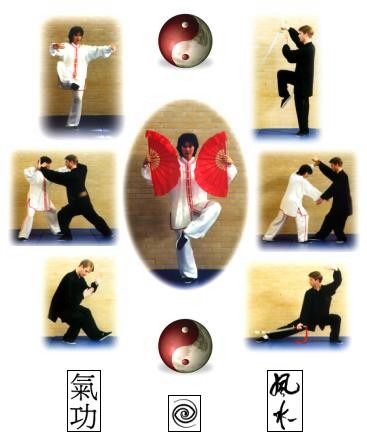
Tao-In
Taoist stretching and body twist exercises (on the floor) is to help your internal life force, or Qi, to circulate more freely, for the purpose of refreshing, attuning, adjusting and regenerating your personal energy. It is a series of postures, which also helps to strengthen the tendons, the Qi flow and lower back. Tao-In improves Iron Shirt and Tai Chi.
Introduction To Chi Nei Tsang
-- (Internal Organ Massage) :
The Taoist sages of ancient China observed that humans often develop energy blockages in their internal organs that result in knots and tangles in their abdomens. These obstructions occur at the center of the bodyís vital functions and constrict the flow of Chi (energy), our life force. The excessive negative emotions of fear, anger, anxiety, depression and worry cause the most damage.
Through meditative practices the sages learned to look within themselves and they discovered the internal organs and how they connect with the Five Forces of the Universe and provide a link between the human microcosm and the universal macrocosm. The organs contain the essences of the spiritual force of a human being. They also provide the physical lines of force that hold the body together and give it structure.
When obstructed, the internal organs store unhealthy energies that can overflow into other bodily systems and surface as negative emotions and sickness. Always in search of an outlet, these negative emotions and toxic energies create a perpetual cycle of negativity and stress. If the negative emotions cannot find an outlet, they fester in the organs or move into the abdomen, the bodyís garbage dump. The abdomen can process some emotional garbage but with frequent dumping, the energetic center of the body located at the navel becomes congested and cut off from the rest of the body.
Obstruction and congestion will also affect the nervous system, blood vessels and lymph glands. These systems cross paths in the abdomen. So if the abdomen is congested, it can cause physical tangling and knotting of the nerves, blood vessels and lymph nodes. The result is the gradual obstruction of energy circulation.
The Taoist discovered that most maladies could be healed once the underlying toxins and negative forces were released from the body. They developed the art of Chi Nei Tsang to recycle and transform negative energies that obstruct the internal organs and cause knots in the abdomen. Chi Nei Tsang clears out toxins, bad emotions and excessive heat or heat deficiencies thus facilitating better Chi and blood flow.
Chi kung reactions
:
Numbness, tingling, itch, heat, cold, light pain, and sweating are common sensations that appear during chi kung and meditation practice. These chi kung reactions are normal. They are mainly due to energy blockages being opened and cleared away. It is an indication that the area where the sensation occurs is being healed. Practitioners can use the mind to spiral the chi in the affected area to increase the rate of healing.
Sometimes an old illness that was thought to be healed may reappear to the surface. This is because the illness wasnít cure completely. It was just hidden deep within the bone and tendon. Since chi kung itself is a healing process, the old illness will reappear again to the surface in order to be healed. With continuous practice, it will be cured and dissolved completely.
When you circulate chi around your body through the meridian channels, you will feel "sensations" in different acupuncture points as the chi arrives. These sensations are useful in opening your microcosmic orbit. Sometimes these sensations can be felt as a ball of energy, electric current, or a stream of energy. It is different for everybody.
Sometime during seated meditation, you might feel drowsy and have the feeling that you are going to fall asleep. But donít worry, you will not actually fall asleep. You are just entering a meditative state or trance (close to alpha brainwave). But donít try to fall asleep either. In this state your body will feel totally relaxed without any tension, almost feeling like it is weightless. When it happened, just relax and observe. Spontaneous Movement is most likely to occur during this stage.
Spontaneous Movement is involuntary muscle contractions that will occur during chi kung or meditation practice. Hands, legs, head, or even the spine will start to move on their own. This is normal and can be beneficial to your practice. Just stay calm and observe. If it starts to move very vigorously and you would like it to stop, just mentally order it to stop. It will then slow down and stop. But donít use your muscle strength to fight against it, doing so might result in injuring yourself. (Using muscular force to stop Spontaneous Movement is inappropriate use of force; it is one of the "three harms")
Seeing images and hearing sounds: sometimes when you close your eyes during practice, you will see different colors of light, geometric patterns, or hear sounds. This is also normal, and there should be nothing to be afraid of. This happens as energy is sent to the higher centers in the head. This happens most often as energy travels through the base of the skull (jade pillow, BL 9), crown of the head (Bai Hui, GV20), and the third eye (Ying Tong, EX-HN3). The brain is directly simulated as the chi travels by, creating images and sounds. But do not confuse this with hallucinations. On rare occasion, one will experience "visions". This dream-like experience can be quite fascinating. But do not take the content of this vision too seriously. This content can be as arbitrary as a regular dream. Learn what is virtuous and beneficial, and discard others.
Cleansing process: during chi kung practice, if you feel like you need to burp, cough, sneeze, or fart, do so. It is just a part of the cleansing process. On some occasions, you might experience slight diarrhea. But unlike the diarrhea you experience when you are sick, you will actually feel energized afterward. This is a cleansing process that clean out your digestive tracts.
DOJO PHILOSOPHY
Training in the Internal Arts isn't just
physical but mental and spiritual.
Each practice is to strengthen and train our
body, mind, energy and spirit.
Nurture excellence.
Respect the founder, the art, your teacher and classmates,
but think for yourself.
Shoshin: Beginnerís mind.
In a beginnerís mind there are many possibilities.
In an expert's there are few.
The principles remain constant but the methods can change.
Seek to improve the art and improve the standard.
Question authority.
Always examine what is taught and what you are told,
find your own understanding.
The study and practice of the internal arts
is to become independent and free,
not dependent on anyone or any system.
Keep thoughts and comments positive and healthy.
Train diligently, refine your body, mind and spirit.
This is your responsibility.
Your teachers can show you the way and help you,
only you can develop the skills.
Argue for your limitations and sure enough theyíre yours.
Next time you say "I canítĒ replace it with
ďI donít want to try.Ē
DOJO POLICY
The Dojo will be run in a traditional manner. Enter with beginner's mind. Sifu/Sensei and assistant instructors set the rules.
All new members regardless of prior experience begin at the beginning. A constant beginner's mind is the path to learning.
Students are expected to be on time for classes.
Students are expected to practice between classes.
This dojo doesnít support competitions, tournaments or fighting.
Cell phones and pages either off or on silent during club hours.
Perfume, cologne or jewelry should not be worn during class.
Dojo is for practice, not chatting.
Students are expected to help each other. If part of a group practice, students must catch up to class if a session is missed.
No food permitted in dojo during club hours.
Weapons are only to be handled by those working on forms requiring them.
Tuishou and partner work is by instructorís permission only.
The dojo is for refining our body, mind and spirit. Displays of ego or anger are not acceptable.
Members are expected to set a good example at all times. Do not show your training, let your
training show.
Members are expected to help keep the dojo clean.
Those with regular attendance will receive priority with lessons.
Assistant instructors and advanced members will be held to a higher standard than other club members.
Overview
of Taiji and Related Terms
Taijiquan
Also spelled T'ai Chi Ch'uan,
pronounced "tye-jee-chwan" (Chinese) or more
commonly, Tai Chi "tye-chee". An enormously popular
martial art/exercise originating in China. Like other
"internal" martial arts, it uses qi and balance,
rather than muscular strength to overcome force. Taiji is
distinguished by its solo practice forms of graceful, and usually
slow dancelike movements and the stylized quasi-sparring exercises
for two-persons called "push hands."
Qi (Ch'i) the "vital
energy," or the energy of life. In Chinese thought, a very
real energy associated with life, health, and strength, and the
foundation of all Chinese medicine. For thousands of years,
Chinese doctors studied the effects and movements of qi, and over
centuries of study, acupuncturists determined what they believe
are the precise channels and nexuses of qi flow.
Neigong (Nei Kung) refers to
any exercise system which develops the body internally, whether
for its own sake, or as wushu, a martial art.
Qigong (Ch'i Kung) refers to
any exercise system aimed at increasing the flow of qi, for
health, healing, spiritual benefit, etc. It does not usually refer
to the four "soft" martial arts which developed in China
to use internal qi in self-defense:
Wushu is now the preferred
term for martial art. Gongfu (Kung Fu) technically could
mean any discipline of any kind, so wushu is a far better
term.
Internal Martial Art, or Internal
Wushu refers to martial arts which depend more upon a relaxed
direction of internal energy and manipulating the opponent's
momentum. This may range from using qi in palm strikes and
punches, to incredible grappling and throwing ability, where qi is
used to "root" oneself and take advantage of an
opponent's unbalanced qi. These are also sometimes called the
"soft" martial arts.



|
Internal Exercise Disciplines
|
|
Chinese Internal Disciplines
|
| Description |
Pinyin Spelling |
Wade-Giles Spelling |
| Any internal exercise |
Neigong |
Nei Kung |
| Exercises to develop qi, usually
excluding wushu |
Qigong |
Ch'i Kung |
|
Internal Wushu (martial arts
emphasizing qi instead of force)
|
The
"Three Sister Arts" |
Baguazhang |
Pa Kua Chang |
| Xingyi |
Hsing-I |
Taijiquan
extremely widely practiced forms, although martial
skills are often neglected. |
T'ai Chi Ch'uan |
the newest soft wushu,
developed from Xingyi |
Yiquan or Dazhengquan |
I-Ch'uan or Da Cheng Ch'uan |
|
Japanese Internal Martial Arts
|
| Aikijujutsu,
"Harmonious Energy" Jujutsu |
| Aikido, "Way
of Harmonious Energy" the most popular
"soft" martial art practiced as such. |
Without a doubt, the forms of taiji
are the most widely practiced aspect of any martial art in the
world today, although the vast majority of its practitioners do
them as a qigong (qi exercise), not as a martial art. When it
comes to an internal martial art being learned fully as such,
aikido is undoubtedly the leader. The "form," the set
movements that immediately come to mind when one thinks of "Taiji,"
are only one aspect of Taiji as a martial art. Full training in a
taiji style also includes qigong practice, "push-hands"
training (two-person exercises), teaching of martial applications
and/or sparring, and weapons forms (Broad sword, taiji sword,
staff, etc.) Some styles, have their own distinctive qigongs, like
Chen style's chansijing or "silk-reeling
exercises."
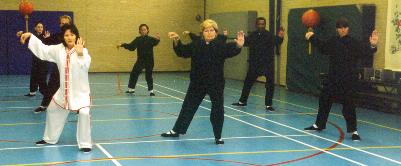
One reason martial applications of
taiji are comparatively rarely taught seems to be that the
patriarchs who developed the various styles felt more comfortable
sharing the solo practice forms more widely than the martial
aspects of the art. The learner still would "get
something," but the teacher could rest assured that he had
full control over who knew his techniques. Zheng Manjing (Cheng
Man-Ching) was largely responsible for bringing taiji to the West,
but taught only one form, (his modification of the Yang form)
exclusively. After a year or so, he might allow a student to begin
"pushing hands." Martial applications were only lightly
taught, and qigong was nearly, if not completely, ignored. A huge
number of American teachers learned from him or from those who did
learn directly from him, and while popularizing taiji
tremendously, this caused the American experience of taiji to be
truncated.
Not that China actually has fared
much better. The People's Republic created a simplified Yang form
(and later several composite forms) for the masses to practice as
an exercise. Literally tens of millions of Chinese practice taiji
forms daily. Only a small percentage know how to use it in
self-defense.
Recently has that been changing.
Now there are numerous schools throughout the world that rightly
see taiji as a martial art and offer the full experience of it to
their students. In China now, many masters are proficient in as
many as 100 forms. The myth of a perfect, sacred form appears to
be dying.
Why did aikido fare better in being
taught intact consistently? Perhaps because of some advantages in
its creation. Instead of being handed down within several
secretive patriarchal lines in a feudalistic society, It was
created by one man, Morihei Ueshiba, in the twentieth century, as
a gift to world. Since he alone created it, he also was able to
insure (at least until his death) that it would always be taught
with a strong spiritual emphasis of joy and love. Ueshiba was fond
of saying that the spirit of aikido was the loving protection of
all living things. Good taiji teachers have the same
attitude.
Taijiquan was originally called
the Thirteen Postures, after the 13 distinct concepts upon which
it is based.
| Eight
actions |
Five motions
|
| Four primary actions |
Four secondary actions |
advancing
retreating
looking (moving) left
looking (moving) right
staying balanced in the center. |
warding off
rolling back
pressing
pushing
|
pulling down
splitting
striking with the elbow
striking with the shoulder.
|
From the list, it's not apparent
that there are punches and kicks. There are, but in taiji
thinking, the energy expressed in them may be warding, pressing,
advancing, etc. When Yang Lu-Chan brought the art of the Thirteen
Postures to the emperor's court in the nineteenth century, it was
called "Taiji" (the Chinese term for the yin-yang
symbol) because it exemplified harmonious balance. "Quan"
means the fist, and indicates that taiji is a "boxing"
discipline. This is true regarding the "discipline"
part, but most forms of taiji use the palm much more often than
the fist.
Because the essence of taiji is in
the 13 postures and the means of generating jing (power)
from the ground up through coiling motions, taiji has proved
extremely adaptable. Especially over the last 150 years, since its
guardians began making it public, it has evolved into dozens of
styles. Styles mutate constantly, mix together, and even borrow
from other arts like Baguazhang. It doesn't matter. As long as it
follows the principles of the Taiji Classics (the descriptions of
the essence of the art written by its founders) and expresses the
13 postures, it is taiji.
However, most of these styles still
flow in the general stream of one or more of the families which
developed it. In the table below, I've attempted to give an idea
of how most of the current styles relate to the original family
styles, how the family styles relate to each other, and in some
cases, to other wushu. Also, I've tried to distinguish between style
as a complete wushu, and form, where the form is the
predominate aspect of the practice. When someone speaks of the
four "major styles," odds are they mean Chen, Yang, Wu,
and Sun although Zhao Bao and Wu Yu Xing (Hao) are also recognized
officially as "major styles" in China.
| Zhao Bao Village
Style (Possibly the original? Or from Chen?) |
Hu Lei Style |
| Chen Family Styles
(The original? Shaolin influence? Or from Zhao Bao?) |
Feng Style |
Fu Style
(Baguazhang influence) |
Yang Family Styles
(from Chen)
The most popular and mutable stream of Taiji |
Ping Kwan Style |
Health-Oriented Forms,
Taoist Taiji |
PRC National Forms
(Simplified Taiji and others)
|
Yang Short Form
(Zheng Style) |
Li Style |
| Wu Yu Xing (from
Yang and Chen) |
Hao Style (now
more popular than Wu Yu Xing) |
Wu Jing Quan
"Wu Style"(from Yang) |
Health-Oriented Forms |
Chang Style (Yang influence) |
Sun Family
Forms(influence from Baguazhang and Xingyi with Wu
Yu Xing) |
| Other Styles: |
Competition Forms |
Combined Forms |
Wudang Style |
Tung Style(from Yang and Wu Yu Xing) |

Chi, Chi Kung, and Tai
Chi--How to Keep them Straight, or Minding Your Chi's, Ji's and
Qi's
If you're new to reading about
taijiquan, the maze of spellings and Chinese words may be
overwhelming at first. Is it Ch'i, Chi, or Qi? Taijiquan, T'ai Chi
Ch'uan, Tai Chi Chuan? Qigong, or Chi Kung? The answer is yes! There
are several different ways of spelling Chinese words with the
Latin alphabet. Chinese words which have been long used in the
West are most familiar in the older Wade-Giles transliteration,
which used only unvoiced consonants (no B,D,G,J, or Zs). Unvoiced
consonant sounds were represented by unvoiced consonants
followed by an apostrophe; all other consonants represented voiced
sounds. For example, T'ai Chi Ch'uan had an unvoiced t
at the beginning, a voiced ch or j sound in
the middle, and an unvoiced ch on the final
syllable--"Tye Jee Chwan." As words became more
familiar, it was natural to drop the annoying apostrophes, hence, Tai
Chi Chuan.
The Pinyin spelling,
designed by the PRC to eventually replace the Chinese characters,
is for the most part more phonetic. Also, logical words and terms
are written as single words, instead of strings of syllables
corresponding to the characters. A few of the vowels are slightly
odd, but really only a few letters and combinations are strongly
counter-intuitive to English speakers--C, Q, X, Z, ZH,and the
vowel OU
C is pronounced like the TS in
TSunami
Q is pronounced like CH
X is pronounced like SH
Z is pronounced like the DZ in aDZe
ZH is pronounced like J
OU is pronounced like the OU in dOUgh
So now, it's taijiquan,
and qi is pronounced "Chee," not "Key."
(Except in Japan, but that's a different story.) Even though the
vast majority of English-speaking people are more familiar with
"Tai Chi" than "Taiji," the Pinyin spelling
system is quickly becoming the preferred one around the world, and
I decided to use it here. Besides, in taiji, you've got
three dotted letters in a row, and you've got to admit, that's
pretty frimmin'. Note that the "Chi" in Tai Chi Chuan
and "life energy" Chi are now spelled completely
differently: the first example has become ji and the
second, qi. Super-literally, "taiji" is
translated as "supreme ultimate" or "grand
ultimate," however "taiji" means the
yin-yang symbol, the "grand, ultimate" symbol of the
interplay of yin and yang. Also, "Taiji" is the name of
the North Star in Chinese.
The Qigong Six Healing Sounds
:
Discover an ancient Qigong (Chi Kung) treasure: six movements, sounds and breaths that can increase your body's natural healing ability and give you unlimited health. Learn how.
Qigong has been an integral part of Chinese culture since ancient China. This art, science and health maintenance system, practiced for thousands of years, uses stillness, movement, visualization, sound and breath in different combinations to strengthen, increase, generate, cleanse, refine, store, balance, circulate and discharge Qi. Qi energy is essential for health, healing, vitality, fitness and transformation of consciousness for spiritual development. Qigong exercises our internal organs, reduces stress, activates the natural healing process inside our bodies, strengthens our immune system, regulates all bodily functions and quiets the mind.
Qi is a universal concept called by many names in different cultures. Everything in our known universe possesses, generates and is surrounded by Qi. Every structure, process and organ in our bodies has Qi. Qi is the key to health and wellness, our life force.
We will be working with Qigong six healing sounds. The exercise uses sound, slow movement and visualization to balance Qi in our body. The relationship between breathing, healing, emotions and thought is well known. Working with the emotions is very important in the six healing sounds. Stress and tension create blockages in the body and blockages in turn create stress and tension. Emotions affect our physical organs and vice versa. Blockage of free flowing Qi can cause malfunction and disease. Using the six healing sounds, negative Qi can be discharged, clearing the blockage and restoring health and vitality. Good free flowing Qi is our body's united power to resist disease and be healthy. If our Qi is in balance our health and wellness are unlimited.
When practicing the six healing sounds, it is very helpful for you to know the location of the organs in your body so you can visualize them. Modern science confirms the ancient idea of visualization. Our bodies respond to mental images as if they were actually happening. The old saying, "Where the mind goes, Qi will follow" seems to be true.
Emotional factors play a major role in your life. You cannot separate the emotional life from the physical. Your feelings live in your body and affect all aspects of it. Here are the seven basic emotions with the organ of the body they affect:
Sadness and Grief affect the Lungs
Fear and Fright affect the Kidneys
Anger affects the Liver
Joy affects the Heart
Worry affects the Spleen
It is good to keep this information in mind in your daily living. We will be using these suggestions in the six healing sounds.
Qigong exercises can be done standing, walking, lying down or sitting. For the six healing sound exercises we will sit.
How to Sit
Sit on the edge of a firm chair, well supported and comfortable. Place your feet flat on the floor, toes pointed straight forward. Keep your ankles and knees in line. Your legs should be placed hip-width apart, thighs parallel to the floor. Keep your back straight but relaxed. Keep your head erect, your nose in line with your navel. Rest your hands on your lap, palms upward. Breathe normally. This is your Rest position. You will use it to breathe and visualize during the exercise, between movements.
How to Breathe
Most Qigong exercises are done slowly to allow the mind to register the movements through out the body. Your breath should be inhaled through your nose and expand your diaphragm. Let the air and your mind go to your dantian (a point four finger widths below the navel). Do not force it, just relax and feel the breath expand this lower part of your body. Most people breathe in the top of their chest, which is a shallow breath, and not as effective as a deeper, full breath. With mindful practice, breathing to your dantian will become natural. Exhale through your mouth (this is where you will make the healing sounds). Your exhale will be longer than your inhale.
The Sounds
All material substances in our known universe are in constant vibration. Sound is capable of great energy, subtle movement and wonderful healing vibrations. The sounds you will be making in this exercise will be loud at first, but later they will quiet and vibrate deep within your body and mind. A sound is always executed on the outward breath. Here are the sounds and their related organs:
Lungs The hiss of a snakeÖ.HISSS
Kidneys Blowing out a candle with cheeks drawn inward
Liver Asking someone to be quietÖ.SHHHH
Heart Blow through open mouth (a few inches) pull cheeks inward
Spleen Blowing out a candle with cheeks puffed outward
Triple Burner Exhale through a tight smile with tip of tongue behind lower teeth
The Complete Exercise
In Qigong everything is connected and related. We will use this relationship in the six healing sounds exercise. Listed next to each organ is the relationship with other elements (we will use this information in our visualizations), the sound for that organ and the movement of the exercise. It is recommended that you do each movement three times, resting and visualizing between movements. You may do as many as you feel necessary but do them in increments of three. (Example: 3, 6, 9, 12, etc.)
LUNGS
Relationship -- White light - autumn - nose -- skin
Sound - SI -- Hiss of snake
Movement:
Sit in a firm chair, relax and breathe normally. Focus on your lungs with your hands on your lap, palms upward (rest position). Start the movement. As you inhale, scoop arms upward in front of you like holding a large ball, until your palms are at eye level. When palms are at eye level rotate palms away from face. Follow your hands with your eyes. Tilt your head backward a little and bring your hands over your head. Eyes should gaze at fingertips (fingertips should be pointing at each other, palms facing upward). Arms remain curved. Heals of palms press upward (feel a comfortable stretch in your arms). At this point exhale completely, making the lung healing sound. Visualize and expel, wet unhealthy energy from your lungs. Let go of any sadness or grief. Breathe naturally and slowly bring your hands back downward in front of your eyes. When at eye level, rotate palms toward face; allow arms to curve downward until hands again rest in your lap. Close your eyes. We will sit relaxed and comfortable for a moment visualizing, until we start the movement again. Breathe normally. With each inhaling breath, visualize beautiful white light entering, surrounding and emanating from your lungs. Feel the connection with your nose and skin. See your lungs strong and clean. With each exhaling breath, silently make the lung healing sound and expel negative wet unhealthy energy from your lungs. Continue this process, after a few moments, start the movement again. Repeat entire exercise as needed.
KIDNEYS
Relationship --Blue light - winter - ears -- bone
Sound - CHUI -- Blowing out a candle with cheeks drawn inward.
Movement:
Sit in chair in "Rest" position. Breathe normally. Focus on your kidneys and start the movement. As you inhale, place feet and legs together. Bend forward with both palms facing toward you. Your left hand clasps your right hand (your left thumb tucked in your right palm). Surround your knees with your clasped hands. At this point, exhale completely making the kidney healing sound. As you make the sound visualize wet, heavy unhealthy energy being released from your kidneys. Let go of fear. Breathe naturally, slowly straighten your arms and gently but firmly pull back. Feel comfortable pulls in the kidney area: At the same time tilt head upward to look straight ahead. Breathe normally and slowly return to rest position, feet and leg apart, hands in lap. Close eyes. Be aware of your kidneys. Breathe naturally. As you inhale, visualize wonderful blue light entering, surrounding and radiating from your kidneys. Feel the connection to your ears and bones. As you exhale silently make the kidney healing sound and visualize expelling negative, slow, wet energy from your kidneys. Let go of all fright, mistrust and self-doubt from your mind and being. As you inhale, bring in blue light, calmness, gentleness and peace to every part of your being: Bring that to your kidneys. Continue this process for a few moments. Open your eyes and begin the kidney healing sound movements again. Repeat exercise as needed.
LIVER
Relationship -- Green light - spring - eyes -- tears
Sound - XU - Shhhh -- Like asking someone to be quiet.
Movement:
Sit in chair in rest position. Breathe normally. Focus on your liver and start the movement. As you inhale, slowly move arms and hands out to sides in a curved motion. Keep palms upward and keep arms curved and relaxed. In a curving motion raise hands overhead. Tilt head back a little, as eyes follow your hands. Interlock fingers and rotate palms upward. Feel the stretch from heal of palms downward through your arms Keep curve in arms. In this posture, lean slightly to the LEFT, exhale making the liver healing sound. Visualize, feel and release excess heat and unhealthy energy from your liver. Let go of all your anger. Breathe naturally and slowly return to upright sitting position, unlock your hands keeping palms facing upward. Slowly lower your hands outward toward your sides in a curved motion until you rest palms upward in your lap. Breathe naturally and close your eyes. Focus and feel your liver. As you inhale, breathe into your liver. Visualize bright, beautiful green light radiating from, in and around your liver. With each outward breath, silently make the liver healing sound and release all negativity energy, anger, aggression and frustration from your being. With each inward breath, feel kindness and gentleness enter your being. Bring this to your Liver. Feel the connection with your eyes. Continue this process for a few moments. Open your eyes and start the liver healing sound movements again. Repeat exercise as needed.
HEART
Relationship -- Pink-Red light -- summer -- tongue
Sound -- KU -- Exhale through open mouth (a few inches) pull cheeks inward
Movement:
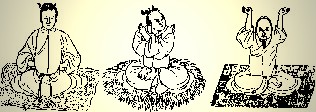
Sit in chair in rest position. Breathe normally. Focus on your heart and start the movement. As you inhale, slowly move arms and hands out to sides in a curved motion. Keep palms upward and keep arms curved and relaxed. In a curving motion raise hands overhead. Tilt head back a little, as your eyes follow your hands. Interlock fingers and rotate palms upward. Feel the stretch from heal of palms downward through your arms Keep curve in arms. In this posture, lean slightly to the right; exhale making the heart healing sound. Visualize, feel and release excess heat and unhealthy energy from your heart. Let go of your pride and arrogance. Breathe naturally and slowly return to upright sitting position, unlock your hands keeping palms facing upward. Slowly lower your hands outward toward your sides in a curved motion until they rest palms upward in your lap. Breathe naturally and close your eyes. Think and feel your heart. As you inhale, breathe into your heart. Visualize bright, beautiful pink-red healing light radiating from, in and around your heart. With each outward breath, silently make the heart healing sound; release all negative energy, impatience and haste from your being. Replace them with love and joy. As you inhale, feel happy and sincere. Bring this to your heart. Feel the connection with your tongue. Continue this process for a few moments. Open your eyes and start the heart healing sound movements again. Repeat exercise as needed
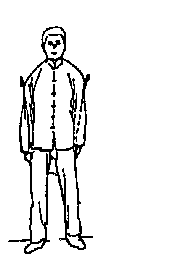
SPLEEN
Relationship -- Yellow-Gold light -- late summer - mouth -- flesh
Sound - HU -- Blowing out candle with cheeks puffed outward.
Movement:
Sit in chair in rest position. Breathe normally, focus on your spleen, and start the spleen healing sound movements. As you inhale, slowly raise hands and place index and middle finger of both hands at the bottom left of breastbone. Press gently and look straight ahead, eyes level. In this position, exhale and make the spleen healing sound. Release excess wet, sticky, heavy energy and gas from your spleen. Let go of all worry and negative thoughts. Breathe normally and slowly return hands to lap with your palms up, (rest position). Breathe naturally and be aware of your spleen. Close your eyes and breathe into your spleen, bright yellow-gold light. Visualize this light radiating from, around and through your spleen. With each outward breath, silently make the spleen healing sound and release all worries. With each inward breath, feel compassion and good will for yourself and others. Feel the connection to your mouth and flesh. Continue this process for a few moments. Open your eyes and start the spleen healing sound movements again. Repeat exercise as needed.
TRIPLE BURNER
Sound - XI -- Exhale through tight smile, tongue behind lower teeth.
Movement: (No movement is related to Triple Burner. It is internal.)
This last exercise is done best lying on your back with legs extended and hands at your sides. Breathe normally and relax. Inhale and feel your body expand. As you exhale, make the Triple Burner healing sound and visualize a large soft roller or gentle loving hands rolling over your body from your shoulders to the top of your thighs, pressing out any negative feelings. Breathe normally and bring your mind back to the starting position. Relax, inhale and feel your body expand with wonderful glowing health. With each outward breath, silently make the Triple Burner healing sound and feel the roller gently press, releasing all unhealthy Qi energy from your body. Feel light, clean, refreshed and free. Repeat exercise as needed. When you are finished, remain in resting position, relaxed and breathing normally. Keep your eyes closed and allow your being to feel cleansed whole and healed. Feel renewed and in harmony with your deeper self and the universe. Feel strong, free and at peace. Light radiates from within you. When you feel you have reached your best healthy state, slowly rise and bring with you all that you have gained, to every part of your life. Live well.
Meditation
Meditation
is now accepted as having a highly therapeutic effect upon the
mind and is used by many professional mental health workers to
help induce relaxation, overcome phobias and bring about
self-awareness.
People meditate to balance their energies, to gain information, to
connection with a deceased loved one or spirit guide, to move
through time, to heal issues, to do light work, and to release the
negative emotions of fear, anger, and rage.
Meditation is your time to connect with the other side. It can be
a rewarding, informative, and connective experience.
There should be no set rules for meditation unless you are in a
group situation. Group meditations can be very powerful as there
is power in group energies.
Meditation does not have to be done in any particular position -
sitting - standing -reclining for any given amount of time on any
particular day, time or place.
MEDITATIONS TECHNIQUES
Some people learn to meditate the first time they try - especially
if they know how to listen to Spirit - the 'little voice in their
head'.
Others develop meditations skills with time and practice.
There should no time parameters on your meditations.
Some days you may meditate for just a few minutes - while other
times you may mediate longer.
You may want to meditate on a specific subject - or just see what
information you receive in general from Spirit.
A tape recorder can be use to play music or to tape messages
during meditation.
PREPARING FOR MEDITATION
Find a place that is quiet and free of distractions.
Adjust the lighting and room temperature.
If you prefer the outdoors - then put yourself in an imaginery
bubble where no one can disturb you. Just see the 'bubble'
surround your body and no one will bother you.
Adjust your clothing for comfort. . .
Remove footwear and eyeglasses.
Sit down or lie down . . .
Find a position that is comfortable for you.
You are now ready to begin . . .
Close your eyes . . .
Take a deep slow breath - breathing in through your nose.
Hold the breath for several seconds as is comfortable for you . .
.
Slowly . . . exhale . . . through your mouth. . .
Feel the toxins in your body release . . .
Take another . . . slow . . . deep . . . breath.
Quiet your mind . . .still your thoughts.
You are now ready to begin . . .
See white light enter your body through your heart chakra. . .
Slowly it moves through ever pour of your body - awakening . .
.filling you with light and unconditional love . . .
You are ready for a journey with Spirit into the light . . .
Relax and enjoy your journey . . .
Three Centered Meditation :
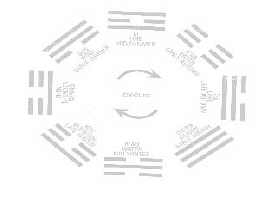
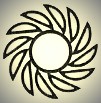
What does meditation mean to you? I asked a few people that donít do it, and aside from a one or two that thought it was nothing more than a waste of time, I got similar answers:
You sit in a motionless position with your legs crossed and do something with your hands - either put them on your knees or touch your fingers. You relax your body and close your eyes. Hopefully you think about Nothing, but if you do think about Something it should be either positive or about things that are bothering you, not about paying the bills or problems with the kids. Sometimes you can use candles and incense, but itís not necessary, and sometimes you can chant to put yourself into a trance. Try not to fall asleep.
Then I asked a few people that do meditate, Why do you meditate? What do you get out of it? Again I got similar answers, and this time their faces lit up just in thinking about it:
Deep calmness, relaxation, personal insight, answers to issues, spiritual bliss. Realizing the connection of mind-body-soul, shutting off the external world and realizing what is really important and what isnít, a mini-vacation each day. Becoming aware of my body and what it tells me of how Iím living, eating, dealing with everyday stresses and situations. To experience true peace, find serenity. My own favorite, to explore the sensations and manipulation of energy flow. And not to forget becoming centered.
What is this "being centered" all about? Imagine that you walk into work one morning. People are rushing about in an obvious hurry to get something done, your boss is yelling, and your computer system is down. Imagine that you breath slowly, deeply into yourself. You are calm as you look around and assess the situation. You quietly walk to your office and put your things down. You sit in your chair, take a slow, deep, full breath, and it suddenly becomes very clear what you need to do to handle the situation. You donít feel anxious, your stress level doesnít rise, and you proceed to do one thing at a time. The madness is happening around you but you arenít consumed by it. You are acting in it but without letting it affect your calmness. The external circumstances donít upset your internal sense of Being. Now imagine doing this with other situations in your daily life. Itís a very powerful way to live.
Each person I spoke to that meditated had their own unique way of doing it, yet they all had one thing in common: Ritual. Most had a special time, a favorite place, and a significant style of music softly playing in the background. All had a pattern of some sort that they followed. For some the ritual was personal, sacred, and they didnít want to share it. Others had created their own approach by using various methods of posture, breathing, and internal imagery.
Itís not so much the details of following a meditation method exactly to a tee, as much as it is the feeling you get when youíre doing it and the sense you carry with you when youíre finished. We use a specific routine in the beginning to learn. Then once we experience and understand, we no longer need that routine anymore to bring us into that space. Of course itís still there if we want to use it, if weíre comfortable with it and it works for us, but now we can personalize our own way of getting there.
I have a meditation method to share called Three Centered Meditation. The purpose of this meditation is to Center Yourself. By practicing a daily ritual of centering oneself, it becomes a natural response to your external environment of everyday life, regardless of what that is like.
The Three Centers in this meditation are fairly universal within spiritual traditions which call them by various names. Chakra is a familiar term that is similar to one of these Centers. The Three Centers are both a physical and imagined space within the body. Basically they represent the body, spirit, and mind. First we bring energy to each Center individually, filling them, allowing them to become open and flowing. Then we connect the Three Centers to realize the oneness, the non-separateness of our body-spirit-mind, our Being. We end by harmonizing the Centers, letting the energy weíve accumulated in them flow through every inch of our body, even into the energetic field surrounding us.
And so I give you Three Centered Meditation, a beautiful way to spend 15 to 20 minutes in a spiritual bliss that you deserve each day:
Three Centered Meditation:

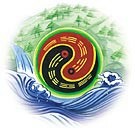
Begin by sitting comfortably, quietly, undisturbed. This can be in a chair or on the floor, however you are comfortable.
Become aware of your breathing. Listen to how your breath sounds. How does it feel? Where does it go in your body? Spend 1-2 minutes doing this.
Become aware of your body, slowly from your head all the way down to your feet. Donít leave anything out. Take a moment to really feel each part - your head, your face, your neck, your shoulders, your arms, your hands, etc.
Do you feel any tension or discomfort anywhere? If so, release it by gently directing the breath to that area. Imagine the feeling of tension softening and melting away, flowing down into the earth as you exhale.
Place the tongue at the roof of the mouth behind the teeth to form a connection between two of the major meridians of the body.
Close your eyes and maintain the awareness of your breath and how your body feels.
Breathe slow, soft, full, and evenly through the nose.
Lower Dan Tien, Center of Personal Power and Inner Strength, the Body
Inhale, directing the breath with the mind deeply into the lower dan tien, the center located just beneath the navel, filling the lower abdomen.
Imagine that you are breathing from this center, inhaling, drawing the breath into the dan tien and exhaling, releasing the breath from the dan tien.
Imagine energy riding with the breath. Breathing in strong and pure energy light, breathing out, softly releasing energy light.
Do this for 8 to 12 slow even breaths.
Middle Dan Tien, Center of Love and Compassion, the Spirit or Soul
Now change the focus of the mind to the heart center at the middle of the chest.
Inhale, imagine your breath drawing the warm, calm energy of love into this center.
Exhale from the center, imagine breath and energy emerging and surrounding you with compassion.
Do this for 8 to 12 slow even breaths.
Upper Dan Tien, Center of Higher Knowledge and Spirituality, the Mind
Change the focus of the mind to the 3rd eye center at the point on the forehead between the eyebrows.
Inhale, imagine both breath and clearly focused energy drawn gently into this center, combining your mind with the consciousness of the universe.
Exhale, imagine both breath and energy emanating smoothly from this center, maintaining the connected feeling of the mind to all there is.
Do this for 8 to 12 slow even breaths.
Connecting the Three Centers, the Body-Spirit-Mind
Bring the focus of the mind back to the lower dan tien, below the navel.
Inhale and imagine a line, or channel, of energy moving upwards from the lower dan tien, passing into and through the heart center, and continuing up to meet the 3rd eye center, connecting the three centers. Feel this channel of energy going up through the middle of your body.
Exhale, continuing to imagine the connection - a channel of energy connecting the three spheres of energy together, feeling the centers as the rhythm of their pulsation flows together.
Do this for 8 to 12 slow even breaths.
Harmonizing the Three Centers
Again bring the focus of the mind back to the lower dan tien, below the navel.
Inhale deeply to the center, feeling warm energy accumulate into a sphere of light, completely filling the lower abdomen.
Exhale and imagine the warm energy emanating and expanding from this center, filling your entire body from the head to the fingers to the toes, even going through the pores of your skin to mingle in the energetic field extending about 12 inches outside your body. This energy field surrounds you completely - front, back, top, bottom, and sides.
Do this for 32 slow even breaths.
Closing the Meditation
Now quietly bring yourself back to external awareness.
Rub your palms together creating energy heat.
Place them over your eyes and absorb the energy through your eyes.
Gently massage your face and head.
Take a moment to notice how you feel and Remember.
This is the feeling you will be able to recall during the day when you need it.
|


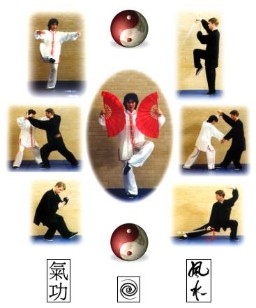
![]() Please click here for
Next Qi-Gong page(3)
Please click here for
Next Qi-Gong page(3)![]()
![]()
![]()


























